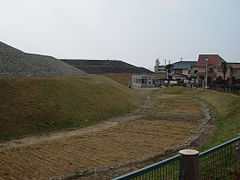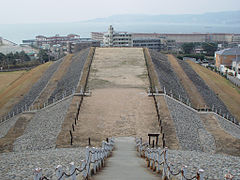Goshikizuka Kofun
The Goshikizuka Kofun ( Japanese 五色 塚 古墳 ) is a Japanese barrow in a so-called keyhole shape ( 前方 後 円 ) in the Tarumi district of Kobe .
The tomb, which was created towards the end of the 4th century or the beginning of the 5th century , is 194 m long (originally over 300 m) and is the largest kofun in the prefecture .
The width of the square front part is up to 81 m, its height 11.5 m, the diameter of the round rear part 125 m and the height of the round part 18 m. The hill is surrounded by a 10 m wide dry trench in which two square heels have been worked: The "east hill" next to the junction between the front and back of the burial mound rises about 5 m high and has a side length of 20 m at the base . The smaller "northeast hill" in the ditch next to the round part of the burial mound rises 1.5 m and bridges the ditch about halfway.
Naming
The "five-color hill " ( goshiki = "five colors", tsuka = "hill"): stones from the area of Akashi Street were used to cover a large part of the Kofun . These dark stones have glittering parts that reflect the sunlight in different colors depending on the time of day.
Because of its shape with a comparatively narrow and (originally) long front part, which resembles an upside-down, thousand times enlarged flower pot, the burial mound is also called Sentsubo Kofun ( 千 壷 , dt. "Thousand Pot").
construction
The first step of the burial mound and the northeast mound were carved out of a natural mound. The second and third stages as well as the east hill are embankments. The entire kofun and the two small ledges in the trench are covered with a layer of round stones. The stone layer was supposed to keep foreign spirits from entering the burial chamber. While the bottom layer was covered with small stones, the top two are covered with larger, fist-sized stones. The original granite stones on the front part come from the northern, but above all from the southern coast of Akashi Strait, i.e. from the north of the nearby island of Awaji-shima . Because of the strong current there, the stones are very round, although they are quite hard. The front part was originally more than twice as long as it is today and reached to the sea.
Along the ledges between the steps and along the edges of the surfaces on the front part and the rear round part, around 2200 haniwa , a good 50 cm high, hollow clay pots, mainly cylindrical in shape, and a smaller part of figures that supported the burial mound, similar to a railing marked the various areas and, together with the stone cover, had a protective function. They had been made upstream of the nearby Fukuda-gawa and brought up the river and across the sea to the Kofun. Two clay cylindrical caskets or urns were found in the north-east hill, on the stone layer of the east hill one found numerous pottery depicting ships and figures. The east hill is interpreted as a pedestal for gifts and grave goods from the mourners.
restoration
As part of a nationwide restoration program of historical sites and buildings, the Goshikizuka Kofun was extensively restored from 1965 to 1975 with funds from the Ministry of Culture and the city of Kobe. The missing two thirds of the square front part of the burial mound could not be restored. This part was removed during the construction of the Japanese State Railways and later the San'yō Denki Tetsudō . During the restoration of the slopes, a coating of clay and sand was laid in order to protect the tumulus from penetrating water. The entire stone cover has been renewed. Original stones could be used for the square front part, but new, lighter pebbles were ordered from other parts of the country for the round main part. As before, the lowest of the three slopes was covered with rather small stones. To prevent erosion, the lower step was covered with soil so that grass can grow on it. A total of 2.2 million stones, 2,784 t, were laid by hand. Replicas of the once numerous Haniwa, which had stood at a density of 18 pieces over 10 m, were only placed on the crown of the round main part of the Kofun. The burial chamber of the Kofun was not touched, as a document from the Edo period says that the chamber was occupied.
Others
Immediately next to the Sentsubo Kofun there is a smaller and possibly older round grave , called Kotsubo Kofun (literally “small pot”). The diameter of the two-tier Kotsubo Kofun is about 67 m, its height 9 m. On the crown and the heel between the steps it was provided with a ring from Haniwa.
Web links
Coordinates: 34 ° 37 ′ 47 " N , 135 ° 2 ′ 45" E





